
Shannon Airport
New facial recognition system will speed up screening time at Shannon Airport, as it becomes the first airport outside of the Americas to have new biometric technology installed for US preclearance. This is good news for Shannon Airport transatlantic passengers as it speeds up their journey through the airport and allows them avail of shorter security screening times than at other airports. The new technology is a further boost to Shannon, which back in 2016 became the first airport in the world to operate a combined EU and US TSA checkpoint system, halving the time spent in security screening at other preclearance airports. The facial recognition technology essentially verifies passengers by matching them to the documents they are presenting.
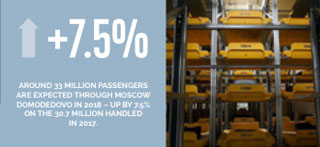
Moscow Domodedovo Airport
Moscow Domodedovo Airport and Vanderlande finished the testing period of BAGSTORE – the automated system for early check-in baggage storage. It’s the first airport in Russia to use Vanderlande’s robotic automated complex for storage and baggage retrieval. The system consists of 7 racks with three-metre height each, resulting in 1,100 storage positions. Six robots move between them on special rails at a speed of 14 km/h to retrieve individual pieces of baggage from the storage and to put it back in the ABHS. Every baggage item is delivered on a TUBTRAX carrier – an individual carrier systems (ICS) that is designed to transport bags in carriers at high speeds over long distances. Bags loaded in carriers are transported smoothly and combine high capacity with faultless tracking.
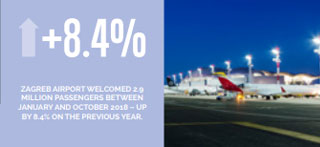
Zagreb Airport
Zagreb Airport plans to handle five million travellers by 2026 and has begun work on upgrading its facilities, in order to enable the passenger terminal to reach its full capacity. The airport anticipates welcoming some 3.4 million passengers this year, which would result in an almost 10% increase on 2017. The airport’s concessionaire noted that it is in the process of adding a fourth baggage carrousel and will open a further 15 check-in desks for a total of 45 this year. Although the €300 million terminal building has the capacity to handle five million travellers per year, the existing equipment is only suited for some 3.5 million passengers per year. The value of the ongoing upgrades inside the terminal are estimated to be worth €15 million.
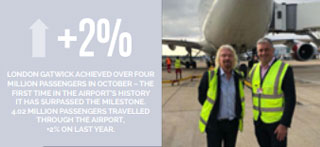
London Gatwick Airport
The first flight fuelled with recycled carbon emissions landed at London Gatwick Airport. The new fuel technology captures and recycles carbon-rich industrial waste gases from steel mills into ethanol – gases that would otherwise go up the chimney into the atmosphere. Virgin Atlantic used LanzaTech’s innovative, sustainable aviation fuel in a commercial flight for the first time. The fuel was used in a Boeing-747 on a flight from Orlando to London Gatwick. Gatwick CEO Stewart Wingate welcomed the flight alongside Sir Richard Branson.
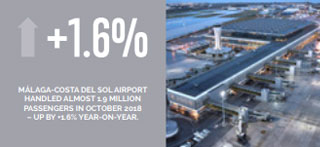
Málaga-Costa del Sol Airport
Aena will invest almost €50 million to renew the services provided to passengers and the infrastructure at Málaga-Costa del Sol Airport. During 2018, €21.3 million will be allocated and in 2019, a further €17.4 million. Taking advantage of the winter season, in which the airport receives less influx of passengers, different parts of the airport will be subject to renovation works to improve the air conditioning, fire systems, floors and the toilets. In addition, all the beacon lights of the taxiway running parallel to runway 13/31 – the oldest of the airport – will be replaced in order to facilitate the manoeuvres of aircraft, in conditions of low visibility.

Helsinki Airport
The one-of-a-kind cinema at Helsinki Airport is a cozy place to enjoy a film with some peace and quiet, away from all the airport’s hassle. Cinema in HEL comes with a few surprising twists. The film is a speciallycommissioned short made in two continents, involving two directors, two actors and two producing partners: Finavia and Finnair. Two people are needed to watch a film. The two cinema seats are equipped with micro tactile switches: only when both seats are taken the lights dim and the movie starts. The walls are painted with what is known as Black 2.0, a paint that reflects almost no light. Despite the small environment, it gives a sense of almost infinitely large space. Cinema in HEL can be found at gate 33, it is open around the clock free of charge.
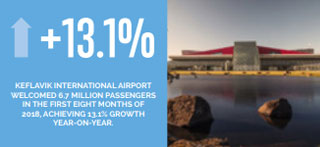
Keflavik Airport
Icelandic airport operator Isavia has unveiled its plans to expand the use of Veovo’s passenger flow management solution throughout Keflavik International Airport. Initially implemented at check-in and security in 2016, the solution provides wait time and occupancy figures to help meet service-level agreements and alleviate overcrowding. In parallel, the airport also deployed Veovo’s Airport Management System for operational visibility to enhance resource management. With the extraordinary growth the airport has experienced in recent years, the two solutions, which consist of sensors and advanced deep learning algorithms, will provide a cohesive picture of how passengers move through and use the airport, enabling more informed operational and business decisions.

Brussels South Charleroi Airport
Brussels South Charleroi Airport (BSCA) and Telenet have announced the signing of a partnership so that the Internet of Things (IoT) can improve the passenger experience. The five-year collaboration aims to make Charleroi Airport a true “digital dome”. Its main objective is to optimise the operation of the airport and improve the passenger experience from home to the boarding gate, thanks to digital solutions such as smart parking, network optimisation Wi-Fi offered to the public and analysis of visitor location data. The partnership will initially focus on two solutions: analysis of passenger flows and a smart and connected parking system.







